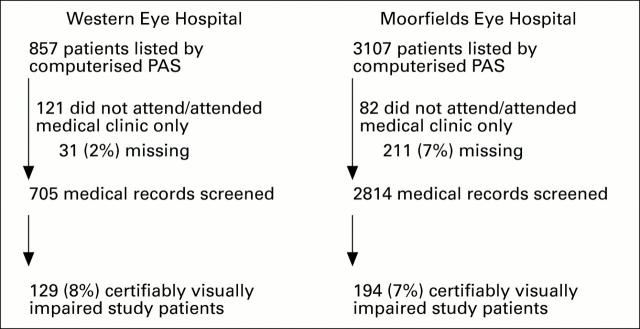Abstract
BACKGROUND—There is debate as to the completeness of the blind and partial sight registers in England and Wales. The purpose of this study was to estimate the proportion of eligible visually impaired people attending the hospital eye service who have a BD8 certificate and to identify factors associated with not being certified. METHODS—Cross sectional survey of patients attending outpatients by medical record review analysed by multiple logistic regression. RESULTS—51% (43%, 58%) of patients identified as eligible for registration did not have a BD8 certificate. The severity of visual impairment and the main diagnosis in terms of requirements for treatment, permanence of visual loss, and visual field loss were independently associated with non-certification. A partially sighted patient is estimated to be three times more likely to not have a BD8 certificate as a blind patient of similar diagnosis (adj OR: 3.4 (95% CI: 1.7, 6.8)). A patient whose impairment is due to abnormal visual fields is estimated to be greater than three times more likely to be non-certified than one with low visual acuity of similar severity and cause (adj OR: 3.6 (95% CI: 1.0, 12.7)). People whose impairment is potentially reversible are estimated to be eight times ( 8.3 (2.2, 31.4)) more likely not to have a certificate compared with people who had permanent non-treatable visual loss; and in those with permanent visual loss, a requirement for ongoing treatment was found to be associated with a lower odds of certification. CONCLUSIONS—These data strongly suggest that epidemiological data collected during registration are biased towards permanent, non-treatable causes of visual loss and those which affect central rather than peripheral vision. Certain subgroups of the visually impaired are likely to be at greater risk of non-certification. BD8 guidelines need to be simplified. Keywords: registration; BD8 certification; data collection; visual impairment
Full Text
The Full Text of this article is available as a PDF (116.6 KB).
Figure 1 .
Flow diagram of the identification of study subjects.
Selected References
These references are in PubMed. This may not be the complete list of references from this article.
- Evans J. R., Wormald R. P. Epidemiological function of BD8 certification. Eye (Lond) 1993;7(Pt 1):172–179. doi: 10.1038/eye.1993.37. [DOI] [PubMed] [Google Scholar]
- Gibson J. M., Lavery J. R., Rosenthal A. R. Blindness and partial sight in an elderly population. Br J Ophthalmol. 1986 Sep;70(9):700–705. doi: 10.1136/bjo.70.9.700. [DOI] [PMC free article] [PubMed] [Google Scholar]
- Robinson R., Deutsch J., Jones H. S., Youngson-Reilly S., Hamlin D. M., Dhurjon L., Fielder A. R. Unrecognised and unregistered visual impairment. Br J Ophthalmol. 1994 Oct;78(10):736–740. doi: 10.1136/bjo.78.10.736. [DOI] [PMC free article] [PubMed] [Google Scholar]
- Wormald R. P., Wright L. A., Courtney P., Beaumont B., Haines A. P. Visual problems in the elderly population and implications for services. BMJ. 1992 May 9;304(6836):1226–1229. doi: 10.1136/bmj.304.6836.1226. [DOI] [PMC free article] [PubMed] [Google Scholar]



